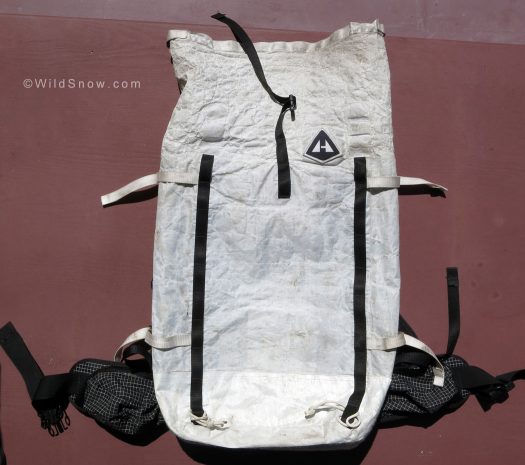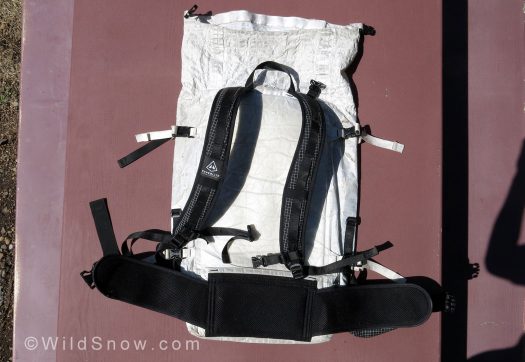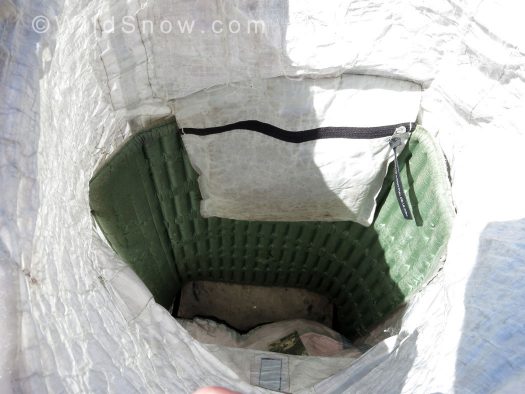
Finding good use for the Hyperlite Mountain Gear Porter pack last week in the Absaroka Beartooths of Montana. Photo: B. Fredlund
As backcountry skiers, what we carry and how we carry it translates into how comfortable we are and how safely and efficiently we travel. Be it sidecountry, ski mountaineering, or multi-day ski touring, we are always using a backpack of some sort.
It’s not a contest, but whoever carries the lightest and cleanest kit, gets the unspoken award. (Does anyone else play that game?)
My contender: Hyperlite Mountain Gear Porter. Fighting weight for the 40L pack: 709 grams.
The Porter is a simple, white colored, top loading, backpack made of 50D Dyneema®/Poly hybrid fabric (formerly called Cuben Fiber). In essence, it’s lightweight, waterproof, and carries gear well.
I’ve been putting the Porter and it’s Hyperlite Mountain Gear kin through the wringer for ski specific use for the last 5 years or so (250+ days per year), and I’ve definitely taken to liking it. A lot. It comes in 4 torso lengths, and 3 volume sizes (40L, 55L, and a 70L version).
The company is based in Biddeford, Maine, where they make all of their products there in house. Hyperlite Mountain Gear specializes in rucksacks, but also offers an assortment of other lightweight Dyneema® products such as shelters and stuff sacks.
Overview
The HMG Porter strikes a nice balance between utility, comfort, durability, and weight. To begin, these rucksacks just feel comfortable — plain and simple. Friends that use these packs also concur. That’s because four back panel size options (S, M, L, Tall) suit your body type.
The waist belt and shoulder straps are ergonomic and wide, with just the right amount of padding. However, like most simple, alpine climbing style backpacks, how you pack your kit is important. This is especially true when carrying heavier loads. I find 50lbs is still relatively comfortable when the pack is filled carefully. That’s commendable given the sub 2 lb. weight of the backpack itself.
The 40L Porter comes with two side compression straps on each side, while the 55L and 70L options have three compression straps per side. There is one small, zippered internal pocket, and the main compartment is sealed with a roll top hook-loop closure, akin to a dry bag. Top compression of the Porter is achieved via an additional 2cm wide webbing strap in a Y configuration.
The proprietary material, a 50D Dyneema®/Poly hybrid fabric, was initially developed for use in sailboat sails. It’s an incredibly strong fabric, and also importantly, waterproof. For skiers, it’s a nice advantage to have a rucksack that keeps your gear dry during bouts of heavy precip, and during long days in the field where your backpack is repeatedly set in the snow.
Additionally, there are two thin, aluminum poles that feed into sleeves in the back panel. They provide additional rigidity and support when carrying heavier loads. These are easily removable.
Note, there is not a separate shovel / probe pocket on the HMG Porter. In my opinion, a large avy tool pocket might be nice, especially when digging lots of snow pits throughout the day, but I don’t find it essential. Worth the weight? Possible, but how about the addition of a skin / crampon pocket as well? The thing is, you’ve got to draw the line somewhere, and HMG has drawn the line with a “less is more” design philosophy.

I brought my HMG Porter pack over to the Cooke City post office, at it tipped the scales at a meager: 709 grams, or 1 lb. 9 oz.
Custom Modifications
Hyperlite Mountain Gear offers the option of an additional a “ski mod” for an extra $100, which includes using fully woven Dyneema® to reinforce the side panels and bottom of the pack, and also includes fixed ski tail holsters on each side. They also offer the option of gear loops on the waist belt rather than of the small pockets that come with the stock edition.
I add a 1/4 length Therm-a-Rest RidgeRest to the interior of the back panel, and tie on a couple short loops of cordelette that serve as traditional ice axe / gear loops. The Porter packs also have daisy chains sewn up the sides for all sorts of custom configuration options (like a snowboard carry system for instance).
Rucksacks take the cake as the piece of gear that is the easiest to modify, customize and tailor to fit your specific backcountry ski touring needs. So by all means, don’t be too shy about getting out the sewing awl or the scissors.
Once You Go Light, You Can’t Go Back
Are the people skiing with the lightest and cleanest kits the people having the most fun? Not necessarily, but it’s possible.
As a ski guide, what my friends and clients carry in their backpacks is something I take note of. And something I think really limits the average Joe and Jane backcountry skier from skiing bigger lines and link ups, and thus having more fun! Perhaps a Hyperlite Mountain Gear Porter could help get the ball rolling in in the low mass direction. Because after your ski/boot/binding setup, your backpack is the piece of equipment that is easiest to save weight with.
If you can save 2+ lbs. on EVERY tour, just in the backpack itself, then that can be a huge help, especially when you are also carrying a rope, large first aid kit, sat phone, radio etc.
It’s said that “the more you know, the less you need to carry.” I’d agree with that to the extent of being practical and not absurd. Along those lines, adopting the go-light philosophy is a process, not an overnight deal. Should everyone adopt the old frontier adage of carrying only what you can carry at a full run? Probably not. But it might be good to consider that perspective from time to time (especially, if like us up here in Montana, we might play tag with a griz now and then).
Beau Fredlund is a backcountry ski guide and photographer based in Cooke City, Montana. He can be found on Instagram at: @bfredlund, and is the owner and lead guide of Yellowstone Ski Tours, www.yellowstoneskitours.com, a ski guiding service that focuses on leading trips in Yellowstone National Park.


